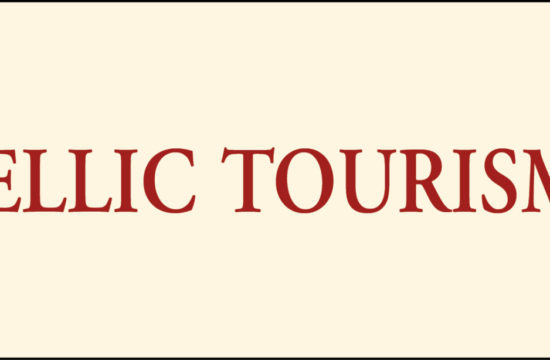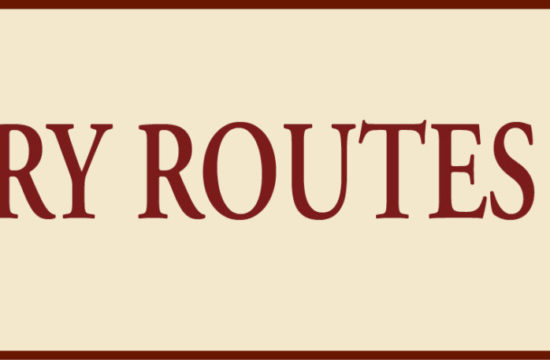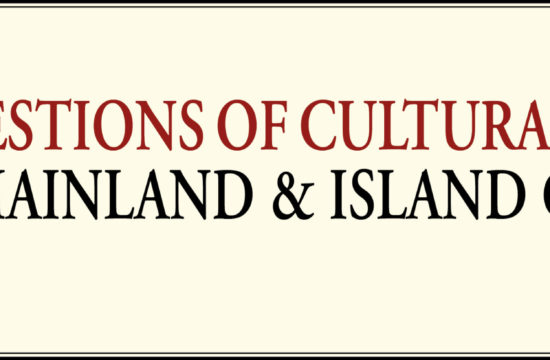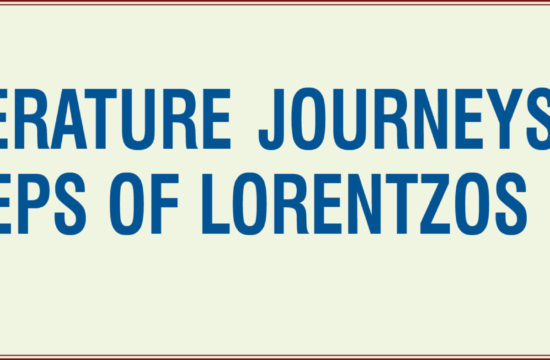Maniou Fotini (fvtinimaniou@yahoo.gr). National and Kapodistrian University of Athens (NKUA), Master of International Studies from the University of Aegean
Koltsikoglou Georgios (g.koltsikoglou@outlook.com). Master of International Law (L.L.M) University of Teramo
Stavridou Georgia (te17008@uniwa.gr). Undergraduate Student – University of West Attica. Department of Tourism Management
Abstract
The present work deals with literary tourism as a phenomenon and its importance in the promotion and financial support of a place. Through three case studies of English authors, whose works and personalities were used for tourism, with the creation of literary routes in Europe, proves that literature as an art form but also as a form of tourism contributes to the development of the economy. Secondary sources were used to document the data, such as scientific articles and books on literature, culture, economics and tourism, as well as ticket price research.
Keywords: literature ,culture ,William Shakespeare,Lord Byron , Agatha Christie.
- Introduction
At the beginning of the 19th century, at a time when the descendants of the European aristocracy had the time and money for all kinds of travel around the world, literary tourism was born. Readers began to travel to the places they met through the pages of books. They began to want to live in the same places where the protagonists of their favorite stories lived, to get to know them better and to give them flesh and blood. Since then, the journey of fantasy has constantly tended to become a real journey, offering emotions and experiences to readers who follow the footsteps of the books’ protagonists or the writers themselves. These literary experiential journeys, an extension of literary tourism, are now defined as „cultural heritage experiences“ and are the subject of ongoing research in tourism studies (Squire, 1994). England was the first country in Europe to gain benefits from this wide field of literary tourism, rightly so, since so many classic writers (Shakespeare, Dickens, Agatha Christie) are English. Literary tourism has now been established as a type of alternative tourism and it’s been chosen by a great number of tourists around the world. (Manola, 2019: 13)
1.1 Literary Tourism
The need of people to experience emotions, led to the creation of emotional tourism. Emotional tourism contains essentially unique landscapes, as well as new and unique experiences, which appeal to tourists emotionally and mentally. Literary tourism is part of the so called “emotional tourism”. In essence, literary tourism is associated with famous and important authors, with their works and the places where they lived. For example, the houses of famous authors are often turned into museums, giving tourists the opportunity to get closer to them. In addition, literary festivals organized which have a global impact and are obviously part of the tourism industry at the place where are organized. (Manola, 2020a). Tourists who choose this type of tourism are often lovers of literature. The motivation of these tourists is to visit a place they have come across in a book or a movie. What excites them is that through these tourism experiences, some of their favorite novels and poems will come alive. (Manola, Balerbas and Kouni, 2020b).
1.2 Literature & Tourism Industry
Various kind of tourism companies get involved with literary tourism, since the tourism industry in this sector is based on notions that are interpreted differently over time and with the change of environment. An author’s influence on the readers is related to factors such as gender, class and nationality, so that texts and concepts are integrated into living cultures and everyday life. Due to the influence of the writers on the society at all, it is possible to create a tourist interest for the place of their birth, or their education, their inspiration, etc. (cultural consumption) (Squire, 1994). Johnson (2009) defines cultural production as „private action that becomes public“. Respectively, he defines cultural consumption as „the process of rendering public action private again“. We observe a literary environment developing for tourism, i.e. the private becomes the object of public observation. When lovers of literary tourism visit countries, cities, with the ultimate goal of learning about literary paths, then the relationship between tourism, culture and society is now defined as „cultural heritage experiences“ and are the subject of ongoing research in tourism studies Manola, 2019a). .
English Authors & Literary Tourism
- William Shakespeare & literary journeys
The places that have been associated with the person of William Shakespeare[1] but also with the heroes of his works, gather great tourist interest every year.
In particular, the theater „Shakespeare’s Globe Theater“, is located in London, where the author presented his performances. It was renovated in the 1990s, and since then, it atttracts tourists who either want to get a closer look at the theater – where Shakespeare worked – or watch a play and recitation of poems. Next to the theater, visitors have the opportunity to observe the exhibition with elements from his life and his work, and for those who are interested in the art of theater, directing, acting, there are experiential seminars they can participate in, held in the same location.
- In addition, the annual Cambridge Shakespeare Festival, lasts 8 weeks, has been established in Cambridge. Every evening, festival visitors watch Shakespeare plays performed by experienced performers. The number of participants is also remarkable, since every year they exceed 25,000. As for the house he grew up, the house he lived in for the last 19 years of his life and the house where his wife grew up, all three are located in Stratford-upon Avon, very close each other. So, tourists interested in learning more about Shakespeare’s life combine three in one, exploring Stratford-upon Avon. A visit to Shakespeare’s birthplace costs 9 pounds for children and 13 pounds for adults. There is also a family package that costs 35 pounds, and there is a option to donate in order to maintain and preserve the house for future generations[2].
- In the church of the Holy Trinity, is the tomb of the author with the famous inscription that prevents anyone from moving their bones. It is said that some of his unpublished works are buried in Shakespeare’s tomb, along with his bones. (Manola, 2019: 14)
It is noteworthy that at the Museum of Contemporary Art in London, there is the famous painting and a statuette of Ophelia, who stars in Shakespeare’s tragic play „Hamlet“.[3]
- Part of the literary roads related to Shakespeare, are two cities in which two of his works take place. The first city is Verona, Italy (Romeo & Juliet), and the second is Elsinore, Denmark (Cronborg Castle). Regarding the first, due to the author’s work, the city has become a symbol of romance and thousands of tourists – in love or not – rush to visit it for its fame. In Verona there is the house of Juliet which was bought and turned into an attraction by the Municipality in 1900. It is open to the tourist public, it’s on the UNESCO list as a world heritage site and many tourists visit it to be photographed on the famous balcony and leave their love messages on the wall of the house. About the second city, the Cronborg Castle located there – built in 1420 – is also a cultural heritage place and tourist attraction. Lovers of literature choose to visit this place as they know it from the film and television adaptations of the ork „Hamlet“, where it is used as a background. Today, anybody can rent the Castle to hold an event or celebrate. (Manola, 2019: 15)
2.1 Lord Byron – Literary Roads
- George Gordon Byron[4] is considered one of the most important English writers of the 19th century, and is one of the most recognizable figures of the Revolution of 1821. He spent much of his life traveling in Europe. Some of the places he stayed at were Lausanne and Geneva in Switzerland, as well as Padua, Ravenna, Pisa and Venice in Italy where he lived for seven years. In fact, while he was in these places, he was inspired for many of his works, and now these cities are associated in history with his name as a cultural heritage. Thus, many of the places where he lived, or even made stops during his travels, now belong to the cultural routes of Europe, and specifically to the literary route „In the footsteps of Lord Byron“.
- One of the countries that has used his „passage“ in tourism, is Albania. He spent 10 days trying to explore Albania on a horseback riding trip with friends (Bhattacharji, 2010). Today, the tourists who visit it, identify the place and nature with the romance of the time of Lord Byron.
- In the neighboring country, Italy, we also find several tourist – cultural routes that follow in the footsteps of Lord Byron, such as the one that leads to one of the most beautiful waterfalls in Europe, La Cascata delle Marmore, where the Lord was inspired for a poem. In addition, the bridge of Venice belongs to the same literary route, which the author named „The Bridge of Sights“ in one of his poems, and thus it has been established until today by locals and tourists, who visit it for the καθηλωτικό sunset that enchants them. (Peterson, 2018). As for Switzerland, the Lord crossed Lake Geneva and then toured the Alps with other authors where he was inspired for some of his works such as „Fragment of a novel“ (unpublished), and „Manfred“ which was later set to music and stands out until today. (Bradley, 2016)
- Lord Byron as a warm philhellene traveled to many Greek cities and islands such as Lefkada, Kefalonia and Messolonghi. He took part in the uprising against the Turks and that is why the Greeks considered him a hero and buried his heart in Messolonghi. Today in Messolonghi, there is an International Center for Research & Study for Lord Byron open to the public, and a museum with his personal belongings. A monument dedicated to the author also exists in the National Garden, in Athens, which is visited by numerous tourists
- In his hometown, England, literary paths have been created concerning his life and death. In addition, there is the opportunity to visit the house-Museum where he lived. Personal items and furniture contribute to the travelers‘ emotional experience. The literary paths in Lord Byron’s footsteps are as follows:
- „A walk on the Wild Side: Lord Byron’s London“ through which tourists visit the places he used to hang out, such as famous theaters, during his four years at the Regency West End in London[5].
- The second literary route is „Find Byron’s Nottinghamshire on the Byron Trail“ which aims at a more emotional tourist experience, as it focuses on Byron’s life beggining from his childhood and ties to his homeland in Nottinghamshire. In detail, the journey begins with a visit to Newstead Abbey, the large piece of land that Byron owned from a young age. Afterwards, tourists have the opportunity to tour Southwell Market, where Byron spent many of his summer school holidays, and finally visit St Mary’s Church in Nottinghamshire, where the poet was buried. This literary journey focuses on the life cycle of Lord Byron, in his childhood, the places where he lived as a teenager and the place of his last residence. The third literary route that concerns our author, is „Woo your loved one on the Lord Byron trail“. This route is quite similar in content to the previous one, as it includes a visit to his house and the family grave[6].
- A place on the tourist map of England, have also won the houses of Lord Byron that today operate as hotel units. In particular, accommodation at Colwick Hall Hotel which was one of the family homes, costs 170 per [7]. Also in Gardener’s Cottage (cost not available in 2020), in which literary tourists seem to show a particular preference for their overnight options. Finally, according to the airbnb website, there are apartments for rent, which are located in Preveza (Greece), Lakefront (Italy), and other places he traveled, and which make use of his name (for example: Lord Byron Apartment).
2.2 Agatha Christie & literary journeys
Agatha Christie[8] didn’t spend much of her life traveling – in contrast to Lord Byron – so her literary journeys have been limited to her hometown (Torquay), Africa (Egypt & Nile River), and Istanbul.
- It is admirable how after her death, her life, her figure and her novels were used for tourism. Starting from Torbey, we come across the park „Potent Plants Garden“ (Torre Abbey), with rare varieties of plants, which were a source of inspiration for Agatha Christie and her works. In addition, in 1990, the English Riviera honored the author with the creation of a bronze statue on Palk Street, where her husband had proposed to her. Many travelers visit the „Princess Gardens“ streets, where Agatha Christie took a walk, inspired by her famous book „The ABC Murders“. The annual Festival called „Agatha Christie Festival“ takes place on the same street, in which a large number of tourists participate. As for this international Festival, it takes place every year on the close dates of Agatha Christie’s birthday and lasts for 4-5 days. Visitors have the opportunity to take part in discussions about the face and life of the author but also to follow the literary paths from which she drew inspiration for her books. In addition, they have the opportunity to participate in mystery games, solve puzzles or even attend theatrical performances related to Agatha Christie’s books. Another tourist attraction is the Torquay Museum, where visitors can see the books, office and other objects belonging to Hercule Poirot (protagonist of Agatha books), and the whole scene from the TV series about Agatha Christie novels, produced by the BBC. In addition, many tourists choose to visit her holiday home, which she described as „the most beautiful part of the Earth“. This house is called Greenway House, it is located on the banks of the river Dart and is built among the trees. Inside the house, there are still personal items of the author, through which tourists can get to know her better. The movie „The Stone Coffin“ which was based on one of her 66 books, was filmed at Greenway House, . The access of the tourists is made either by train through a green scenic route, or by the river by boat. (Manola, 2019: 29 – 30) In addition, there is the possibility of accommodation, where the cost per night starts from 1500 [9].
- In 1907, the author, following her second husband and archaeologist Max Mallowan, arrived in Egypt where she was inspired for the story „Crime on the Nile“, while making the standard trip to the river of the same name. Tourists visiting Egypt today can take the same ride on the Nile, on the same ship (Steam Ship Sudan) that the author traveled on. Last but not least, the Pera Palace Hotel in the Beyoglu district of Istanbul is also a point of interest for tourists who love literature, especially Agatha Christie. This is because in room 411, the author began writing her famous book „Crime on the Orient Express“, which (Orient Express) continues to this day to operate routes to and from Istanbul. (Manola, 2019: 31)
- The contribution of literature to the economy of a country
Literary tourism seems to have impact both on the economy of a place or a country, and the formation of the national image. Due to the connection of novels with nature and literary organizations for tourist purposes, we now get to talk about a form of sustainable tourism development. (Squire, 2009)
According to Watson (2006: 1,2), the growing tourism industry promotes as a tourist product the places of writing or narration of anthologies and books of English literature, and attracts the interest of both British tourists and foreigners. Literary tourism has made a significant contribution to the economies of Britain and North America, especially in rural areas. In other words, it is an opportunity for the development of alternative economic activities in rural areas. (Yiannakis & Davies, 2011) This is due to the effect that the books of famous poets and writers seem to have on tourists – consumers as regards rural areas, since their approaches are usually highly romantic (Pitchford, 2008). It is notewothy that the „local literary assets“ allow many communities to develop tourism activities and industries (organizing festivals & creating museums), to diversify existing and replace declining trade sectors (Yiannakis & Davies, 2011).
Literary places are no longer exclusively for literary lovers or professors who make a research about a writer. Instead, they attract a large number of tourists, as they have become tourist destinations that meet every modern need of consumers, which of course contributes to the strengthening of the local and national economy. (Muler, 2006).
Brown, Hoppen and Fyall (2014) say that investment plays a catalytic role in the development of literary tourism. In particular, they say it is important to ensure that property owners who are interested in tourists are willing to maintain their properties and make them available for tourism purposes and for modern writers to accept that literary tourism is commercialized. Thus, the development prospects of literary destinations will increase. In addition, it is emphasized that since we are now talking about mass tourism, potential visitors should understand the quality of literature, the value of the books, poets, and cultural heritage in general, without necessarily having a high level of education. Finally, it is stated that if the tourism product and services (experiences) that will be formed, meet or even better, exceed the expectations of consumers, then there are prospects for long-term development.
Of course, in order literature continue to be a tourist attraction, the competent bodies will have to act accordingly, to be modernized, to improve their practices for the planning and organization of the tourism industry. If the importance of product design and marketing strategy is not taken into account, the development of literary tourism will gradually decline (Masi, Day & Godsell, 2017).
- Conclusions
It’s evident that literature as a form of alternative tourism, can be a new source of income for places related to authors and their works, it can create new jobs in the tourism industry internationally (organizing literary trips, organizing literary festivals, maintenance of museums, etc.) and consequently contribute to the growth of a country’s GDP. Therefore, the tourism managers of each country should take their cultural heritage seriously into account, focus on the part that comes from famous authors, poets, and their works, and make use of the available resources for tourism. As concerns the culture, literary tourism is an opportunity for tourists to get to know and get in touch with the culture of each country. Through literature, through the authors who have stood out to date, the history of the characters in their books, visitors broaden their spiritual horizons and gain new experiences. The host countries, for their part, have the opportunity to highlight both their cultural heritage and identity related to literature, but also to promote through tourism various tourism activities and products.
References
Airbnb, ( 2020). Lord Byrons Apartment. [online] Available at: https://www.airbnb.gr [Accessed 15 December 2020].
Bhattacharji, S. (2010). “’I Like the Albanians Much‘: Byron and Three Twentieth-Century British Travellers to Albania”, Liverpool University Journal, Vol.38, pp.39-48. https://doi.org/10.3828/bj.2010.7
Boz, M. (2020). Myths and Legends in Destination Tourism Marketing: The Story of Hero and Leander—Canakkale, Turkey. Heritage Tourism Beyond Borders and Civilizations, Springer, Signapore. https://doi.org/10.1007/978-981-15-5370-7_1
Bradley, (2010). Following in Lord Byron’s Swiss Footsteps. [online] Available at: https://www.swissinfo.ch [Accessed 15 December 2020]
Brown, L., Fyall, A., Hoppen, A. (2013) “Literary tourism: Opportunities and challenges for the marketing and branding of destinations?”, Journal of Destination Marketing & Management, Vol3, pp. 37-47. https://doi.org/10.1016/j.jdmm.2013.12.009
Herbert, D. (2001). “Literary places, tourism and the heritage experience”, Annals of Tourism Research, Vol. 28, pp. 312-333. https://doi.org/10.1016/S0160-7383(00)00048-7
Jiang, L., Xu, H. (2016). “The growth of literary places in ancient town tourism destinations: based on the theories of Bourdieu, Danto and Dickie”, Journal of Tourism and Cultural Change, Vol. 15, pp. 213-228. https://doi.org/10.1080/14766825.2016.1148153
Johnson, R. (1986). The story so far and further transformations, D. Punter (Ed.), Introduction to Contemporary Cultural Studies, Longman, London, pp. 277-313
Kalantzis, G., Tompros, N., Tsiamis, C., Poulakou-Rebelakou, E. (2011). “Lord Byron’s first voyage in Greece (1810) and the neglected case of malaria”, Journal of the Royal Society of Medicine, Vol. 104. https://doi.org/10.1258%2Fjrsm.2011.100309
Manola, M. (2019). LITERATURE, TOURISM, CULTURE, pp.11-31. Published by Tsiotras, Athens.
Manola, Μ. (2019a). The Impact of Information Society and Cyber – Culture in Greek Tourism Phenomenon. Informatica Economică, vol. 23, no. 1/2019, 61-71, indexed in Google Scholar, Repec peer-reviewed.
Manola. Μ. (2020a). Literary Tourism as a phenomenon – Examples in Greece & Italy. [online] Available at: Web day. 27/11.INTEREEG GREECE ITALY.POLYSEMI. https://bit.ly/3746TZT [Accessed 27 November 2020].
Manola. Μ, Balerbas, A., & Kuni, S. (2020b). Veneto’s Experiential Approach through books – From Travel Literature to Literature Tourism. International Review of Social Sciences G ISSN: 2309-0081 Vol. 8, No.9.
Manola M., Kouni, S. & Koltsikoglou, G. (2020c). Shakespeare’s Influence on Venetian Literature – Grand Tour and Literary Routes.
Masi, D., Day, S., Godsell, J. (2017). “Supply Chain Configurations in the Circular Economy: A Systematic Literature Review”, Sustainability, Vol.9. https://doi.org/10.3390/su9091602
Muller, D. (2006) “Unplanned Development of Literary Tourism in Two Municipalities in Rural Sweden”, Scandinavian Journal of Hospitality and Tourism, Vol6, pp.214-228. https://doi.org/10.1080/15022250600667433
Peterson,( 2018). Crossing the bridge of sights. [online] Available at: http://www.disappearingman.com [Accessed 12 December 2020]
Pocock, D. (1987). Geography and Literature, “Sage Journals”, Vol.12. https://doi.org/10.1177%2F030913258801200106
Shakespeare Birthplace Trust,( 2020). Plan your visit. [online] Available at: https://www.shakespeare.org.uk [Accessed 10December 2020]
Shaffer, M. (2013). See America First: Tourism and National Identity, 1880-1940. (e-book) Smithsonian Institution. Available at: https://books.google.gr
Squire, S. (1994). “The cultural values of literary tourism”, Annals of Tourism Research, Vol. 21, pp. 103-120. https://doi.org/10.1016/0160-7383(94)90007-8
Squire, S. (1996) “Literary Tourism and Sustainable Tourism: Promoting ‚Anne of Green Gables‘ in Prince Edward Island”, Journal of Systainable Tourism, Vol4, pp. 119-134. https://doi.org/10.1080/09669589608667263
The Byron Society, 2020. Welcome to the Byron Society. [online] Available at: https://www.thebyronsociety.com [Accessed 15 December 2020]
Visite England,( 2020). Find Byron’s Nottinghamshire on the Byron Trail. [online] Available at: https://www.visitengland.com [Accessed 14 December 2020]
West Country Holidays,( 2020). Greenway Apartment. [online] Available at: http://www.westcountryhols.co.uk [Accessed 15 December 2020].
Yiannakis, J., Davies, A.(2011). “Diversifying rural economies through literary tourism: a review of literary tourism in Western Australia”, Journal of Heritage Tourism, Vol.7 pp. 33-44. https://doi.org/10.1080/1743873X.2011.618538
[1] William Shakespeare (1564 – 1616) Born and raised in England, wrote numerous poems and plays. Many consider him the „national poet“ of the country. His plays have been translated into various languages and are still performed in many places around the world.
[2] www.shakespeare.org.uk
[3] www.tate.org.uk
[4] Lord Byron (1788 – 1824). English aristocrat, poet, politician, philelline and one of the leading figures of Romantic movement. He is considered one of the greatest British poets and remains popular even today. He was an extremely famous and successful poet, but also a highly controversial figure in England, due to his unstable economic and love life.
[5] www.thebyronsociety.com
[6] www.visitengland.com
[7] www.booking.com
[8] Agatha Christie (1890 – 1976) Agatha Christie was born and raised in Torquay, Devon. She has written 66 novels and is one of the best-selling authors, after Shakespeare’s Bible and books. Her novels usually dealt with murders caused by a poison, as she found herself particularly interested in plants, the production of poisons and their antidotes.
[9] www.westcountryhols.co.uk









